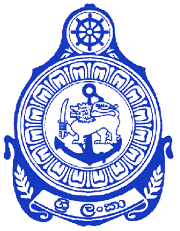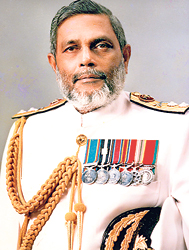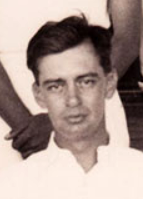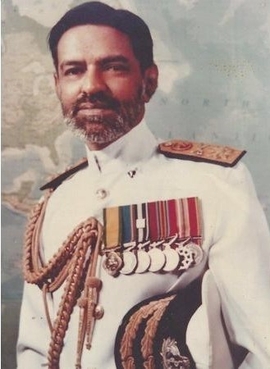
Sri Lankabhimanya Lakshman Kadirgamar, PC was a Sri Lankan lawyer and statesman. He served as Minister of Foreign Affairs of Sri Lanka from 1994 to 2001 and again from April 2004 until his assassination in August 2005. Lakshman Kadirgamar served as the President of Oxford Union in 1958-59.
The Ceylon Defence Force (CDF) was established in 1910 by the Ceylonese legislation Ceylon Defence Force Ordinance, which reformed the Ceylon Volunteer Force (CVF) that existed previously as the military reserve in the British Crown colony of Ceylon. At the time of forming it was only a reserve force but soon developed into a regular force responsible for the defence of Ceylon. The CDF was under the command of the General Officer Commanding, Ceylon of the British Army in Ceylon if mobilised. However mobilisation could be carried out only under orders from the Governor.

After the outbreak of the Second World War, in the British Crown Colony of Ceylon, the government of Sir Don Baron Jayatilaka assured the British King and his government of its continued support.

Admiral Sir Geoffrey Layton, was a Royal Navy officer. He was in command of the submarine HMS E13 when, under attack from German vessels, it ran aground off the Danish coast during the First World War. Despite this incident, he rose to senior command in the Second World War and retired in 1947. His final appointment had been as Commander-in-Chief, Portsmouth.

The Sri Lanka Navy (SLN) is the naval arm of the Sri Lanka Armed Forces and is classed as the country's most vital defence force due to its island geography and is responsible for the maritime defence of the Sri Lankan nation and its interests. The role of the Sri Lanka Navy is to conduct operations at sea for the defence of the nation and its interests and conduct prompt and sustainable combat operations at sea in accordance with the national policies.

Admiral Wannakuwatta Waduge Erwin Clancy Fernando VSV, USP, MNI was a senior Sri Lanka Navy officer. He served as the Commander of the Sri Lanka Navy from 1 November 1991 to 16 November 1992, when he was assassinated by the LTTE he was the most senior officer in the Sri Lankan armed forces to be killed in the line of duty.

Colonel Frederick Cecil "Derek" de Saram, OBE, ED was a Sri Lankan lawyer, a Ceylon cricket captain, and an officer of the Ceylon Army. He led the attempted military coup of 1962.
The 1962 Ceylonese coup d'état attempt was a failed military coup d'état planned in Ceylon. A group of Christian officers in the military and police planned to topple the government of Prime Minister Sirimavo Bandaranaike during the night of 27 January 1962. Organised by Colonel F. C. de Saram, Colonel Maurice De Mel,, Rear Admiral Royce de Mel, C.C. Dissanayake, Sydney de Zoysa and Douglas Liyanage, it was to take place in the night of 27 January 1962, but was called off as the government gained information in the afternoon and initiated arrests of the suspected coup leaders before the coup was carried out.

Vice Admiral A. H. Asoka de Silva, VSV was the Commander of the Sri Lanka Navy from 1983 to 1986. He was the first Sri Lankan Ambassador to Cuba.
Admiral Deshamanya D. Basil Gunasekara was the Commander of the Sri Lanka Navy from 1973 to 1979.
Sam J. C. Kadirgamar Jr., QC was an eminent Sri Lankan lawyer.
Admiral Jayanath Colombage, RSP, VSV, USP, FNI is a Sri Lankan flag officer and diplomat. He was the Secretary of the Ministry of Foreign Affairs until 2022, prior to which he served as Additional Secretary to the President for foreign relations. A career naval officer, he had served as the Commander of the Sri Lankan Navy, the professional head of the navy from September 2012 to June 2014.
Vice Admiral Hikkaduwage Ananda Silva, VSV was a Sri Lankan senior naval officer who was the 11th Commander of the Sri Lankan Navy.
Admiral Alfred William Henry Perera, VSV, ndc, psc, SLN (1930-2009) was the Commander of the Sri Lankan Navy from 1979 to 1983. He also served as the Sri Lankan High Commissioner to Kenya.
Rear Admiral D. V. Hunter was a Sri Lankan naval officer, who served as the 7th Commander of the Sri Lankan Navy.
Rear Admiral Gerard Royce Maxwell De Mel, OBE was a Ceylonese admiral. He was the Captain of the Royal Ceylon Navy from 1955 to 1961, the first Ceylonese to hold the post. He was accused and convicted in the 1962 Ceylonese coup d'état attempt.
Rear admiral Conan Anthony Mohan Jayamaha, RWP, VSV, USP, psc, SLN was a Sri Lankan Admiral. He was Commander, Northern Naval Area of the Sri Lanka Navy when he was killed from wounds sustained in a land mine explosion that killed 7 other senior military officers including Lieutenant General Denzil Kobbekaduwa in island of Kayts while making preparations for Operation Final Countdown the proposed invasion of the Jaffna Peninsula.
Samuel Jebaratnam Christian Kadirgamar I, JP, UM was a Ceylonese proctor.
Brigadier Christopher Allan Hector Perera Jayawardena (1898-1986) was a Ceylonese forest conservator, military officer and socialite. He was a Senior Assistant Conservator of Forests, Equerry to Queen Elizabeth II, Aide-de-camp to the Governor-General and Chief Commissioner of the Sri Lanka Scout Association
The Ceylon Royal Naval Volunteer Reserve was the volunteer naval reserve of the British Crown colony of Ceylon from 1938 to 1950. Established as the Ceylon Naval Volunteer Force (CNVF) on 1 January 1938 under the Naval Volunteer Ordinance, No, l of 1937. It was made up of volunteers mainly from the mercantile sector of Colombo consisting of 12 officers and 18 sailors, under the command of the newly commissioned Commander W. G. Beauchamp. The first headquarters of the force was set up on 11 January 1939, just before the outbreak of World War II, at Kochchikade.






